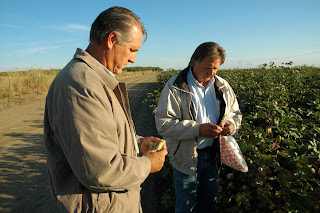A steady procession of big rigs, cars, SUVs, pick-ups and
other vehicles zipped by on one of California’s busy rural interstate freeways.
 |
| Colored cotton fiber has found a niche. |
Nearby, two hand harvesters worked a small cotton field. One
boll at a time, the pair plucked a variety of dark brown and light brown cotton
fibers and stuffed their bounty into black trash bags. The workeda single
cotton plant from bottom to top before moving to the next one.
Overhead, bees buzz around. Ouch. A bee sting.
“It’s a lot of work,”
field scout Carlos Silva says about hand harvesting a small field of unique
colored cotton fiber. “We have been working about four hours a day.”
Carlos and fellow field
scout Jenna Mayfield switched hats last Monday, Tuesday and Wednesday and began
working as cotton pickers. They were hand harvesting one of two small fields of
colored cotton fiber planted by Windfall Farms. They return this week to finish
picking the field along Interstate 5 on the Westside of the Northern San
Joaquin Valley.
 |
| Mark Fickett, left, and Frank Williams inspect their crop. |
Carlos estimates they picked more than 30 pounds of cotton
daily from the field, which is about six rows wide and some 100 feet long.
Windfall Farms is operated by long-time cotton growers Frank
Williams and Mark Fickett. The two business partners have dabbled in colored
cotton on the side for years. Their green and brown cotton fibers have been
used in color blending to reduce the impact from bleaching and dying cotton.
The
two innovative growers have been active participants with the Sustainable
Cotton Project and San Joaquin Sustainable Farming Project andthe programs’ efforts
to reduce chemical use in farming. Their colored fiber has attracted interested
from a niche market of spinners and brands interested in producing sustainable
products. This year’s crop is being sold to Quince and Co. a specialty yarn
company based in Maine.
 |
| A brown cotton boll ready for harvest. |
Wearing a floppy hat and long-sleeved shirt, Carlos’
hand-harvesting routine is to sit on a bucket while picking bolls one plant at
a time. The weather, with temperatures in the mid- to high-70s, was slightly
above normal for this time of year. Besides the weather, Carlos and Jenna had
to fend off bees flying around the field in search of nectar.
It’s likely they are one of the few – if not only – hand-harvesters
working the cotton fields in California or even the United States. We’re used to seeing
large harvesters rumbling through the cotton fields. The mechanical harvesters
can work four or more rows at a time, picking around 1,200
plants in 30 seconds. In one day, a harvester can pick 100,000 to 190,000
pounds of cotton.
 |
| Hand harvesting cotton in Turkey. (Janice Person photo) |
Overseas, though,handpicking is a common sight in some
countries. You’ll see it in different areas of Turkey, India, China and Africa.
These field workers can pick 20 plants in around nine minutes during their
eight- to 10-hour day. That’s about one-ninth of a pound per minute.
We’ll see how Carlos and Jenna do as they gain more
experience. “We’ll be back again to pick more cotton,” Carlos promises.
No comments:
Post a Comment